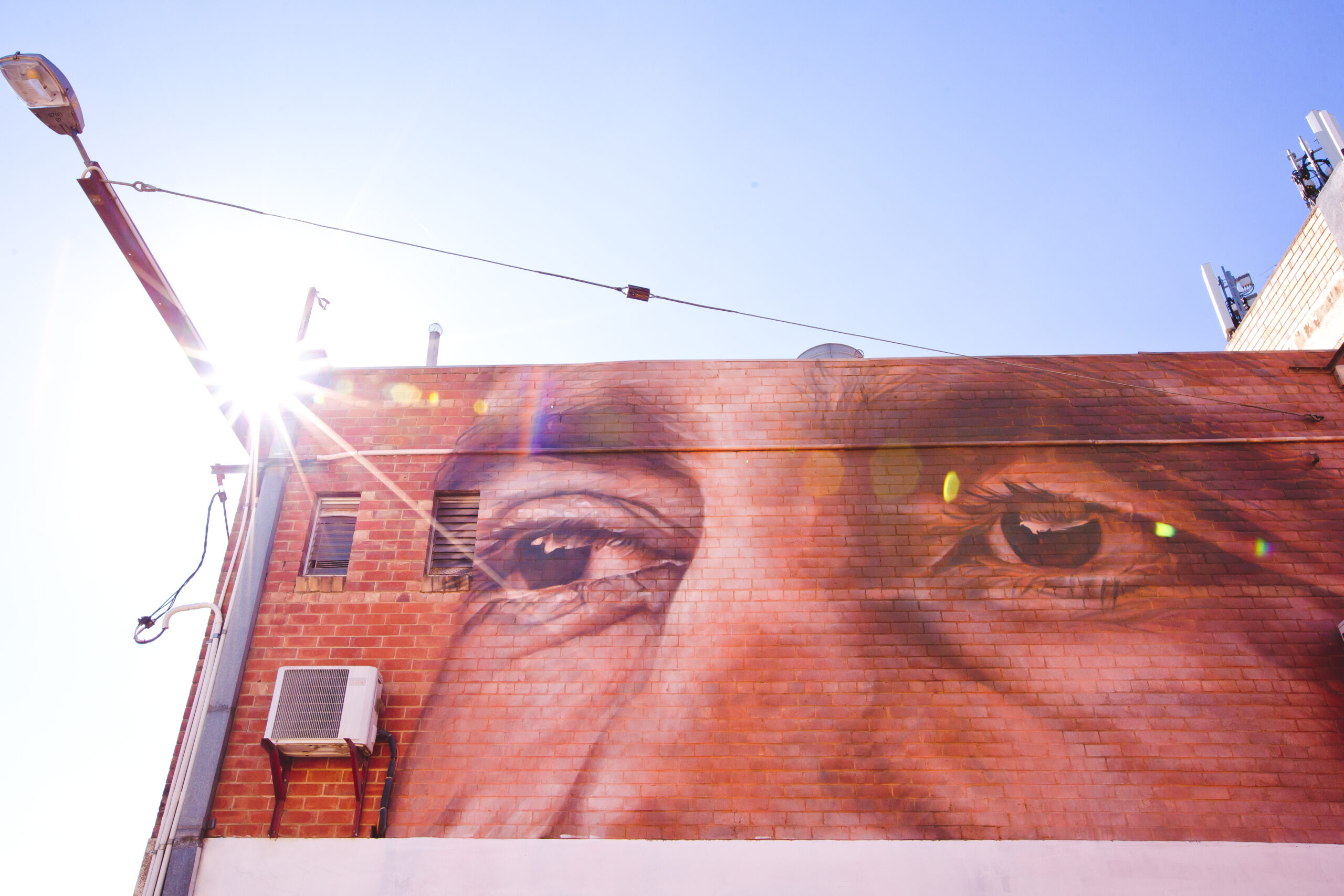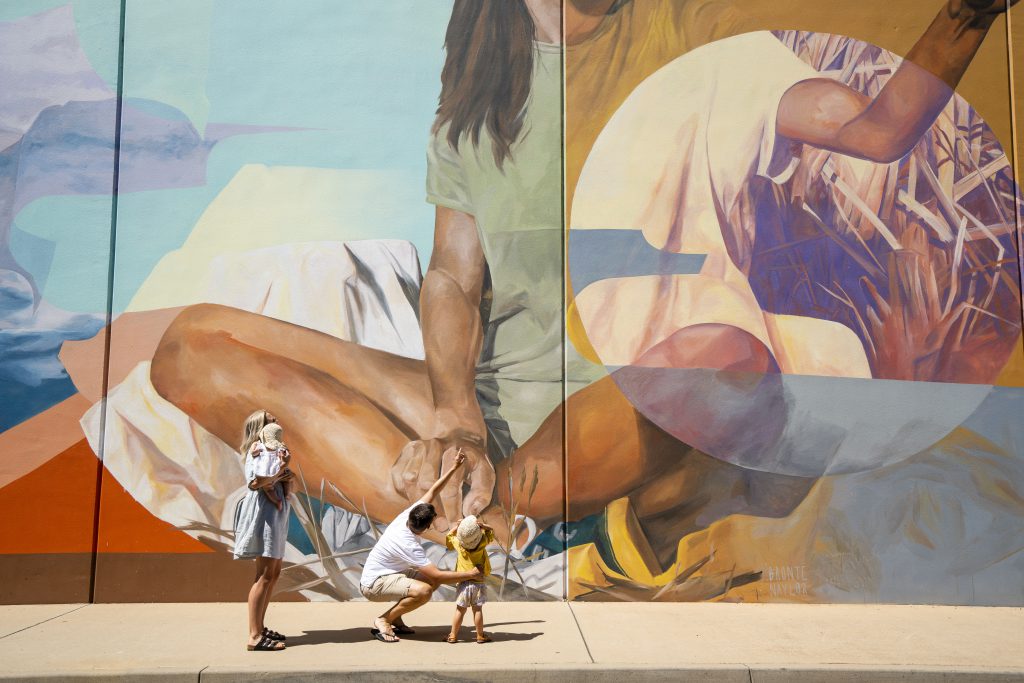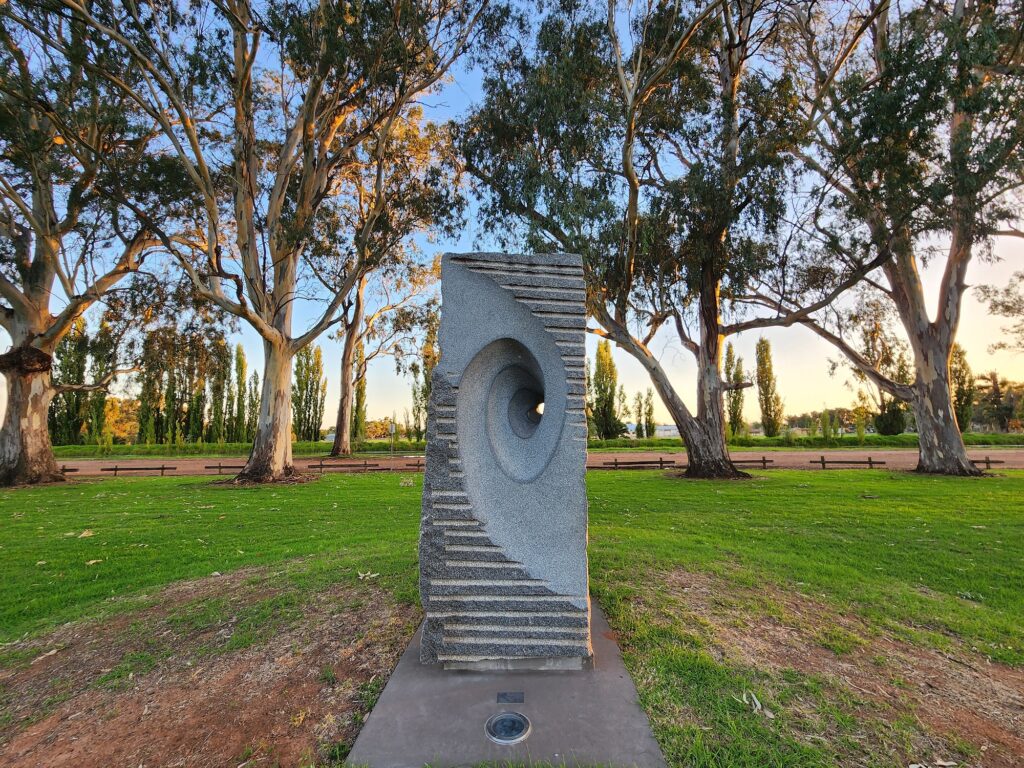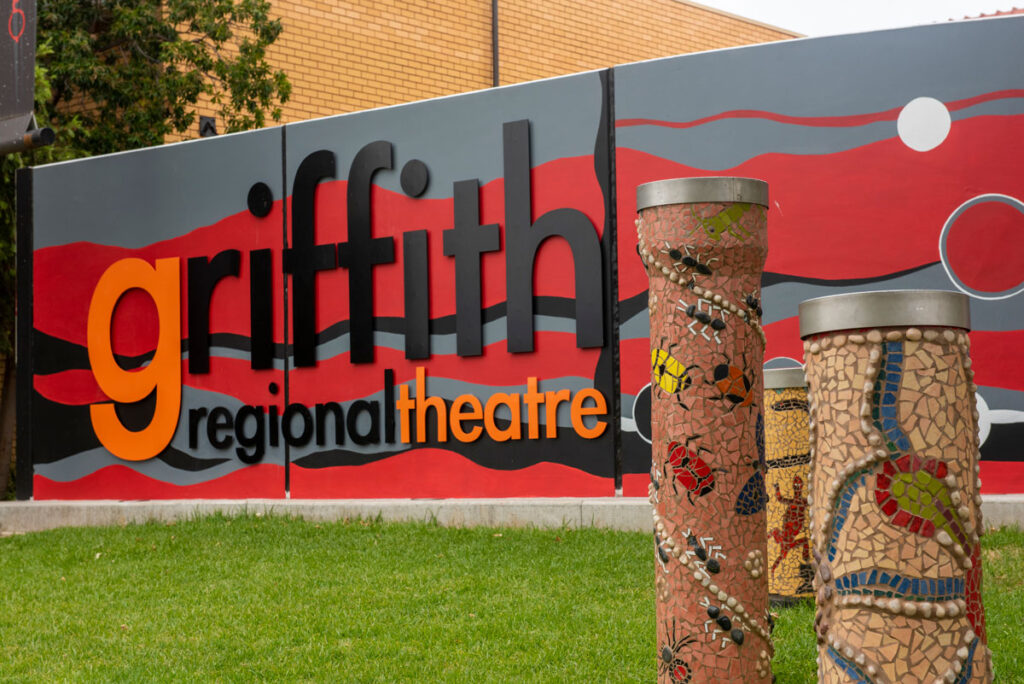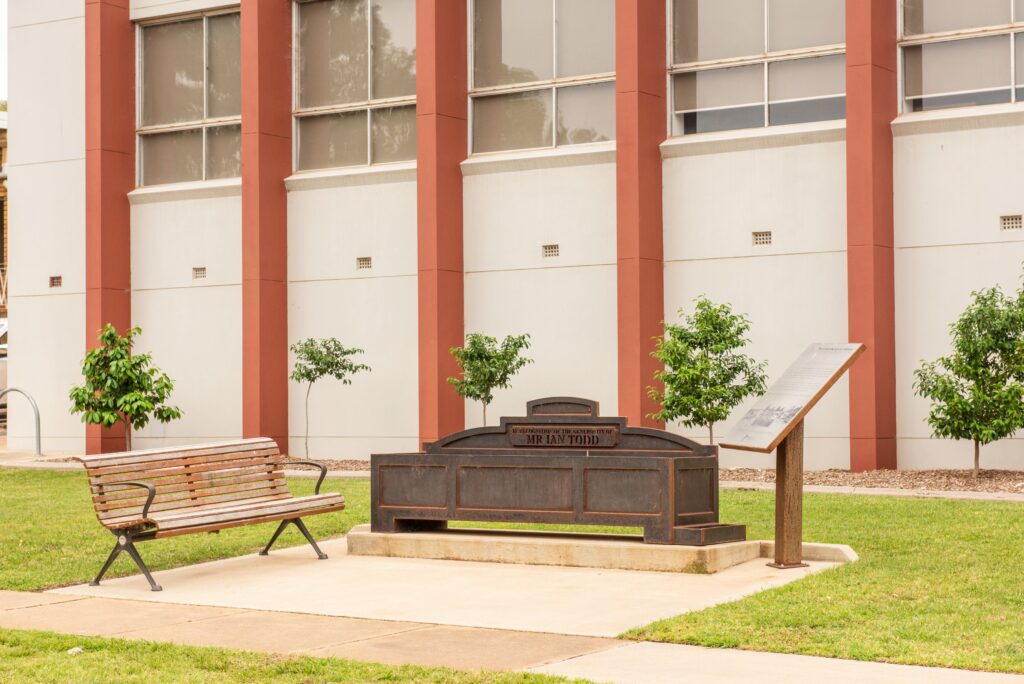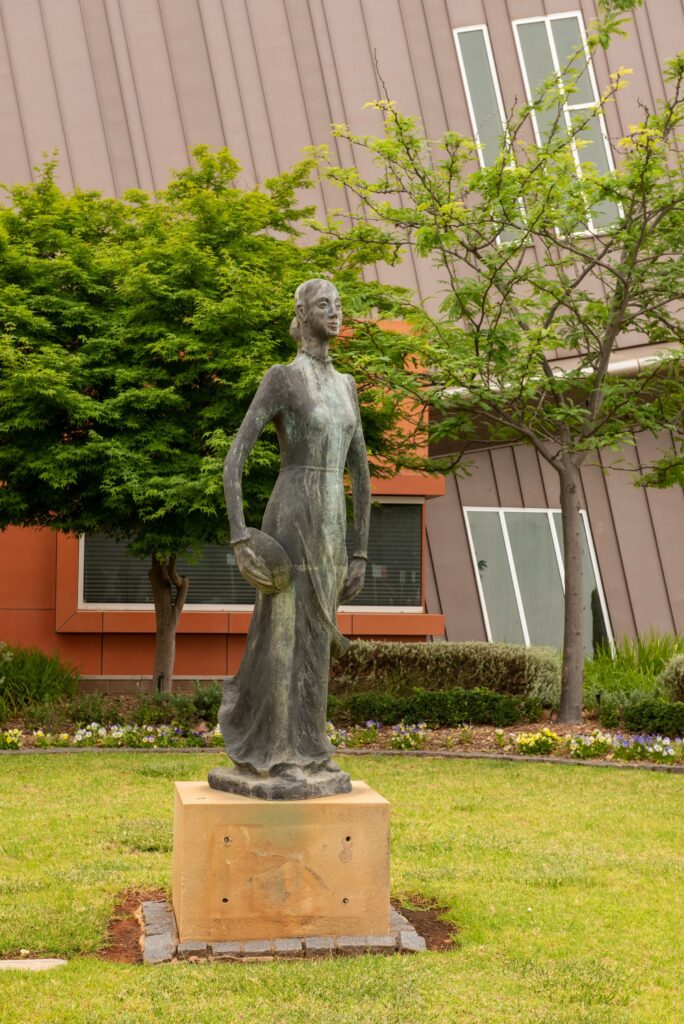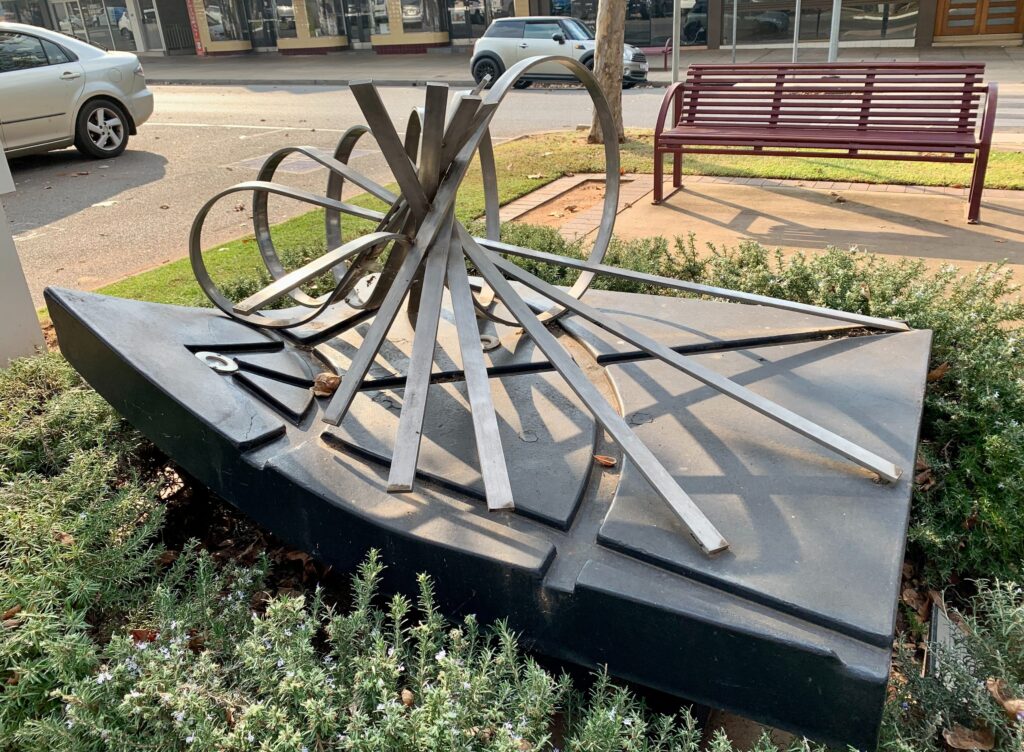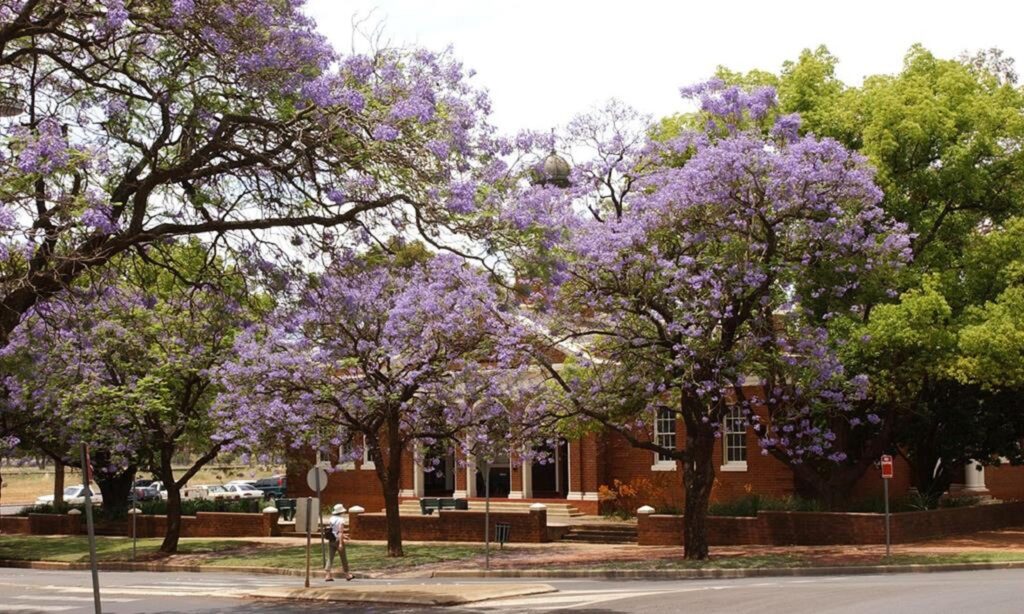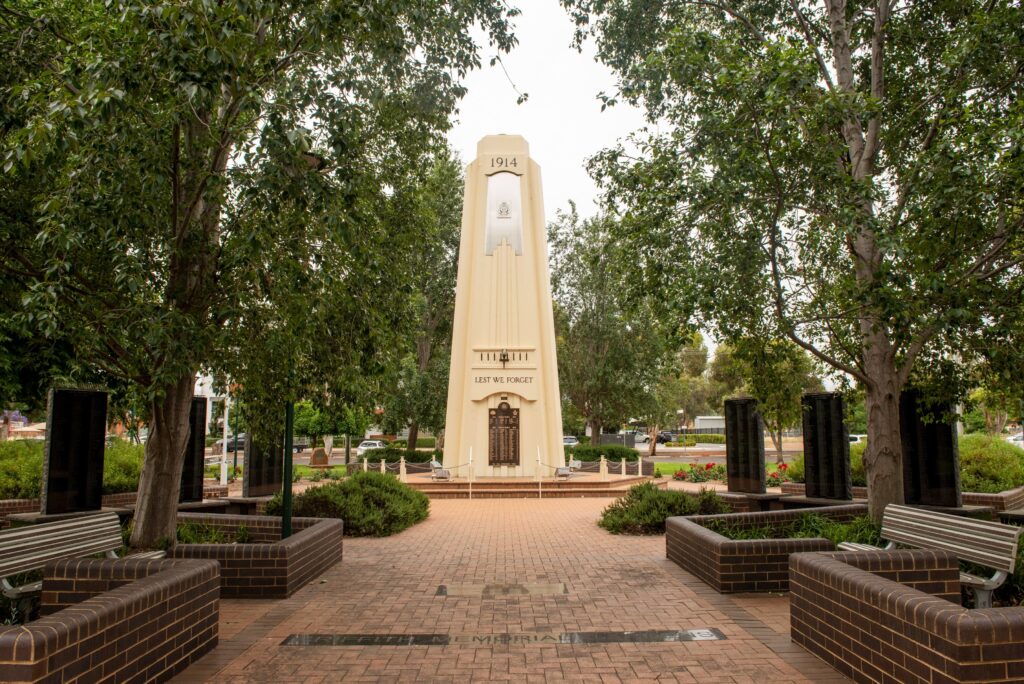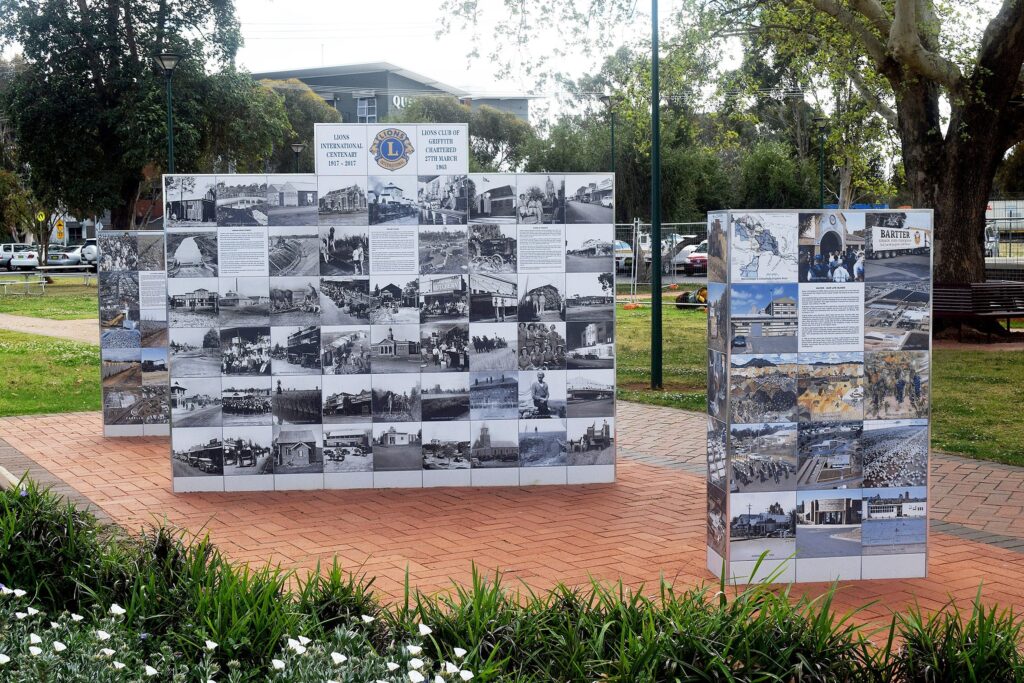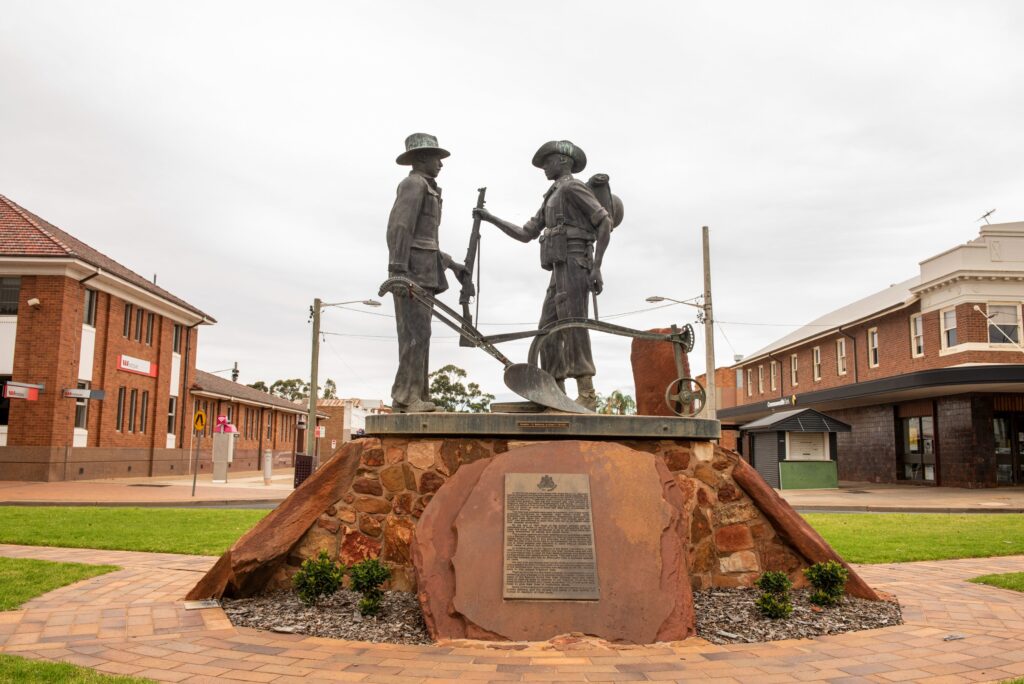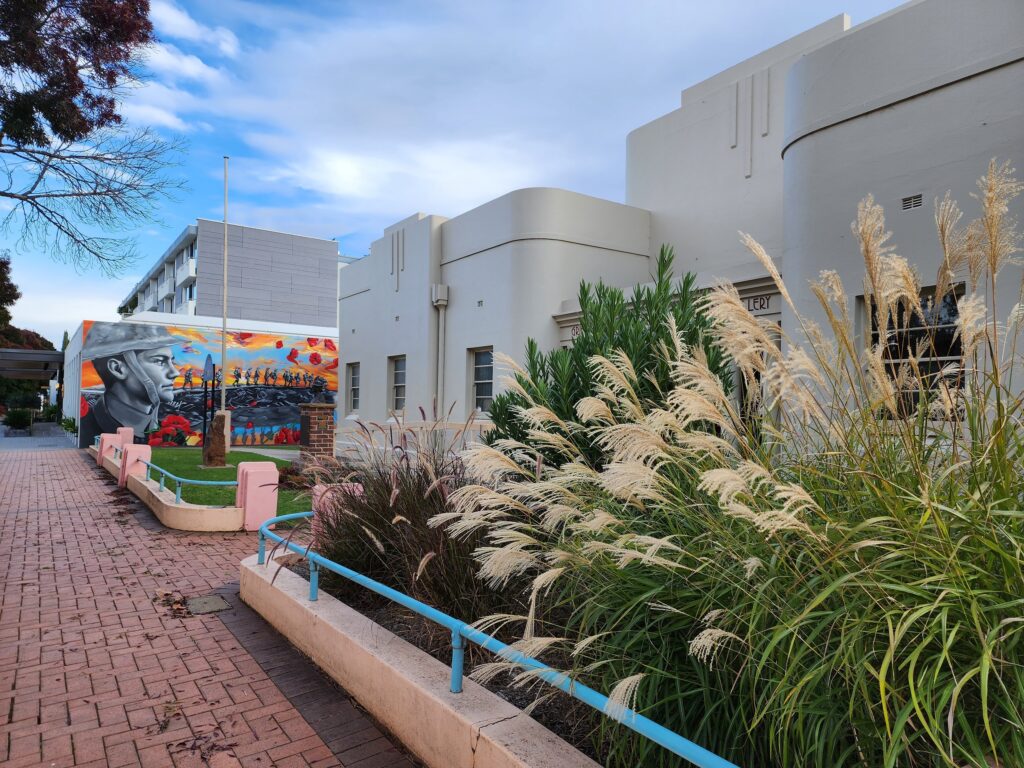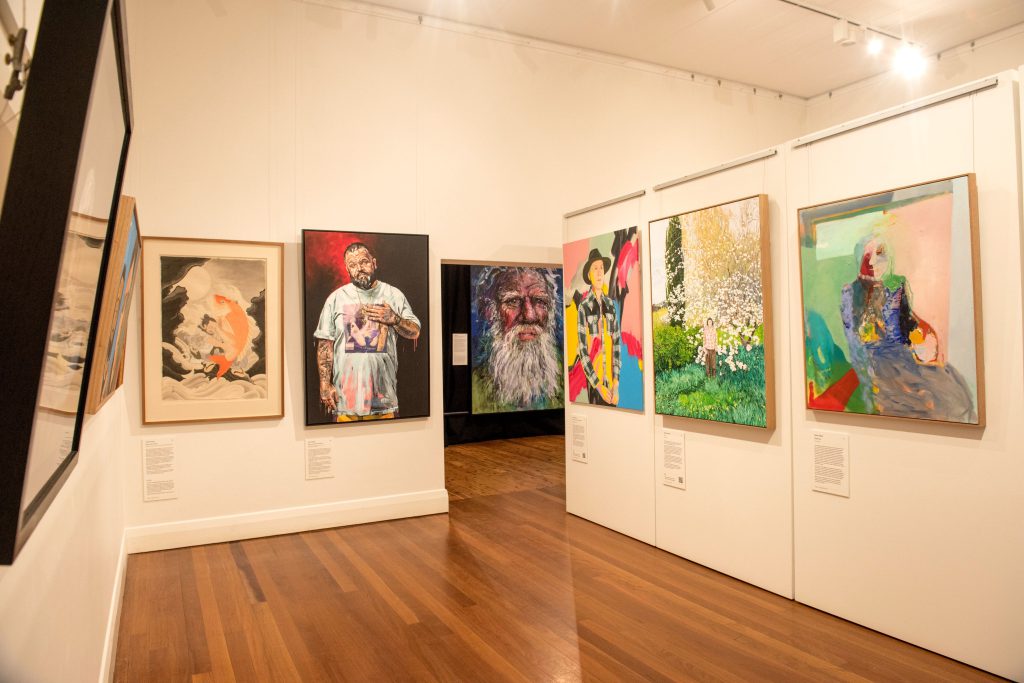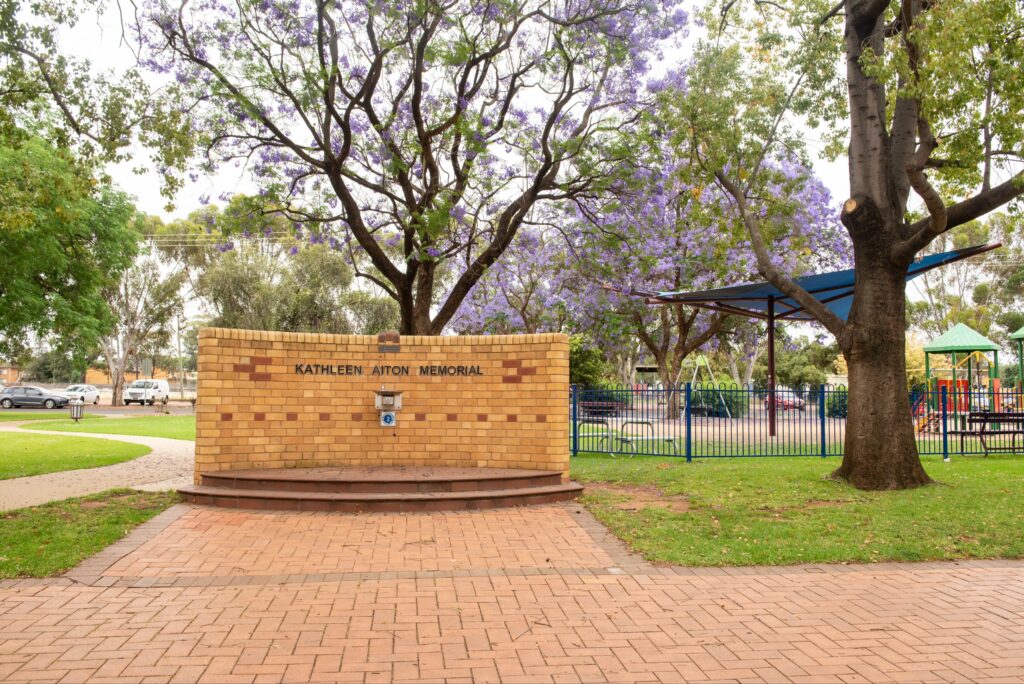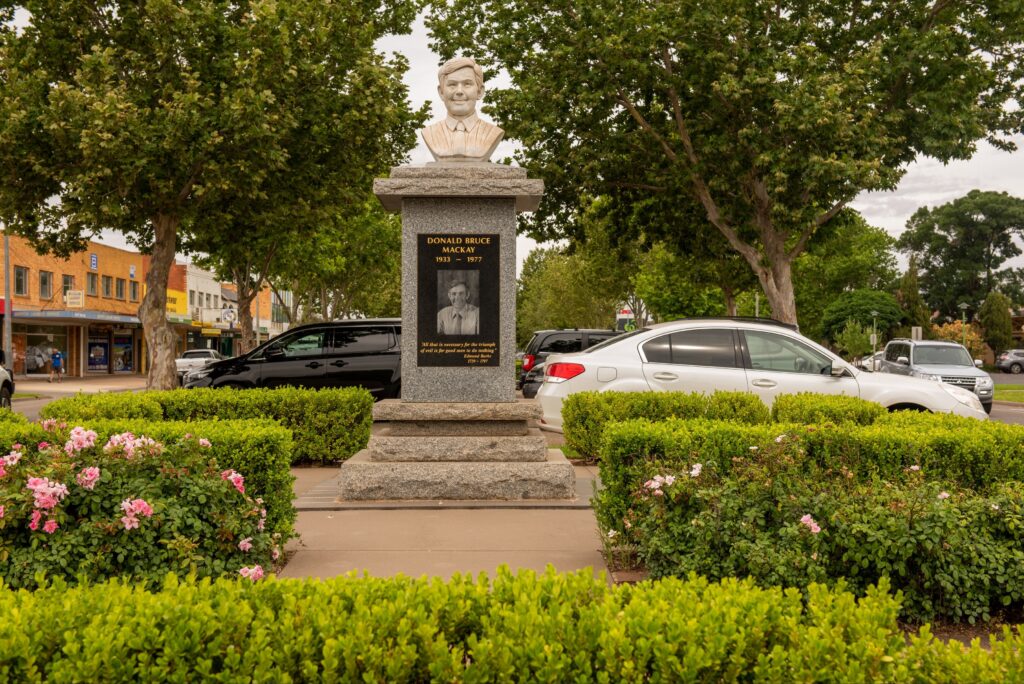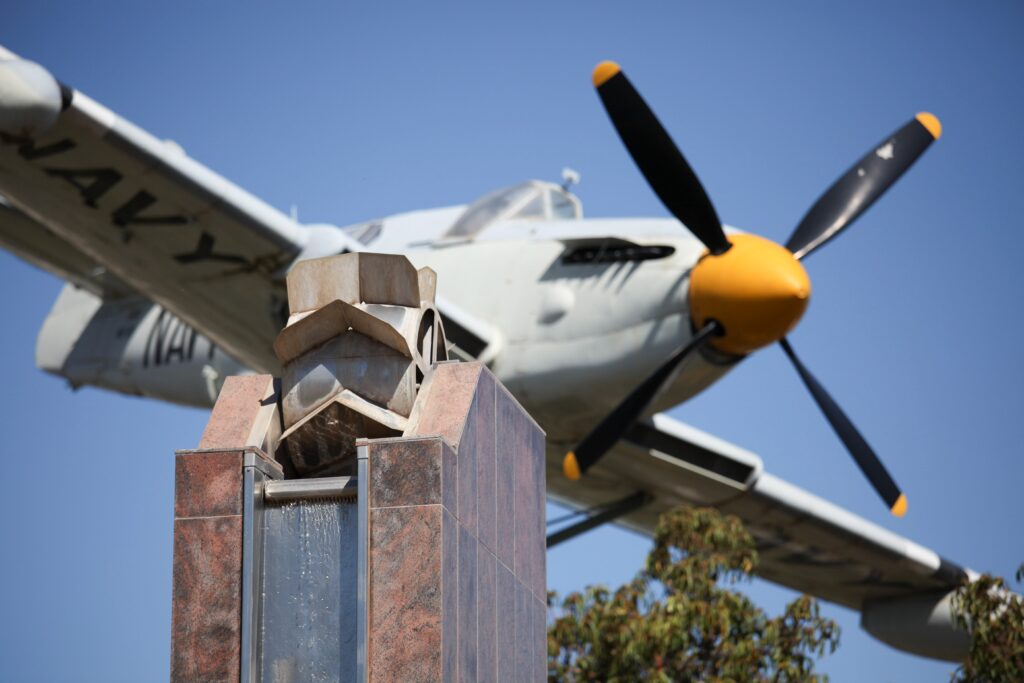Arts & Culture Walking Trail – Suitable for Walking, Cycling & Pram
Dabble into the history and culture of our region starting at the Tourism Hub, take a trip down Banna Lane to be inspired by the large-scale murals presented in your course. Continue through the City Park precinct towards our Centenary Sculptures before you circle back into the main street where you will find a range of elegant memorials and monuments that each pay tribute to many who once served their community. Be sure to pop into the Regional Art Gallery and War Memorial Museum along the way.
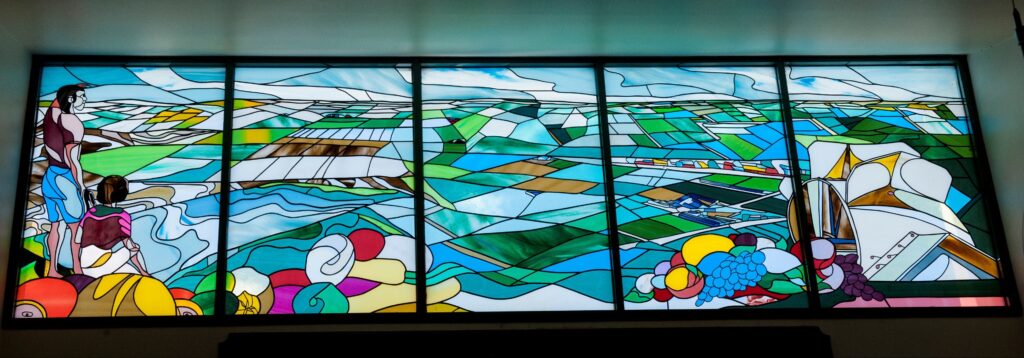
Stained Glass Window at the Griffith Tourism Hub
Call into the Griffith Tourism Hub and take the time to look up! View the kaleidoscope of colour which is the Stained Glass Window.
Depicting the landscape of Griffith from the Hermit’s Cave Lookout at Scenic Hill, the magnificent artwork features the Dethridge water wheel, which is synonymous with irrigation system and produce of the area.
Local artist Sam Di Fiore lovingly devoted his time and talent together with the community to see this artistic icon come to fruition in August 2003.
While in the Griffith Tourism Hub chat to local tourism professionals and gather information on what’s on, where to stay and eat and what to see and do, including walking and cycling trails, National Parks, lookouts, lakes and wetlands, birdwatching, places of interest, and many local experiences and tours.
The Hub also has a wonderful gift shop stocked up with the largest range of regional produce, from olive oil and balsamic vinegars, jams and honey, relishes and sauces, nuts, olives, prunes and other sweet treats.
Select from the range of ready-made regional produce hampers, or customise your own – the perfect gift to take back to friends and family! You will also find Griffith merchandise and Australiana giftware in the shop.
Banna Lane Murals
Love street art? Why not take a self-guided tour to view the large-scale murals and painted padmount transfers down Banna Lane which runs parallel behind Griffith’s main street.
Painted by some of Australia’s leading mural artists, we recommend Saturday afternoons and Sundays for an optimal time to view the artwork without too much traffic in the lane.
The Banna Lane Festival won the following categories in the 2022 Australian Street Art Awards, announced in February 2023:
Griffith Centenary Sculptures
Griffith celebrated 100 years of progress in 2016. The Centenary Celebrations hinged around the 17 day International Sculpture Symposium, which was held during May. Seven of the world’s best hard stone sculptors converged on Griffith to transform 20 tonnes of granite into beautiful pieces of public art. The granite sculptures, which reflect the theme ‘Griffith’s cultural diversity and the meaning of water’ are located on Centenary Walk, in the IOOF Park in Kookora Street.
The sculptures were launched in August during the Centenary of Griffith celebrations. Story and signboards provide details of the international sculptors and the generosity of the local business community and people of Griffith. Lit up at night, the Sculptures make great night viewing.
Cultural Mosaics and Indigenous Murals at Griffith Regional Theatre
A striking mural representing the Wiradjuri people welcomes you to the Griffith Regional Theatre. This eye-catching mural by the late Veronica Collins, a local Wiradjuri artist, sends a message about inclusivity and recognition highlighting the continuing presence of the Wiradjuri People as traditional owners of the land. Complimenting, and positioned in front of the mural are several mosaic totem poles also representing the local indigenous culture.
Be sure to check out the mosaic wall and sculpture at the entrance to the Theatre depicting a patchwork landscape and colourful scenes.
Contribution of the Horses Memorial
Griffith acknowledges the contribution of horses – silent, hardworking partners of man.
Just outside of the Griffith Council Chambers sits a rustic memorial acknowledging the contribution of the horse to the history of Griffith – an iron replica of a Bills Horse Trough.
Horses were an integral tool in the construction of irrigation canals and farm works. Draught horses were used for hard and heavy tasks such as carting heavy loads and construction. Water from the irrigation canals is the life blood of Griffith and the construction of the massive infrastructure of the irrigation canal system was totally reliant on the horse power.
In general, horses were used on the farms to harvest fruit, transport people and goods, mustering sheep and cattle and day to day works. Horse drawn carriages and sulkies were the main form of transport for the school children, farmers, government offices, mail, milk and bread runs.
Bills Horse Troughs were manufactured in Australia and installed to provide relief for working horses in the first half of the twentieth century. A trust fund through the will of George Bills financed around 700 troughs in Australia and 50 overseas.
Nancy Blumer Memorial
Sitting at the top end of Banna Avenue, this stunning memorial is a tribute to Mrs Nancy Blumer, a local citizen who devoted her life to the people of Griffith.
Mrs Blumer was responsible for forming the Girl Guides Association in Griffith, and later the CWA Younger set. When the World War II broke out, she become Commandant of the W.A.N.S. in the Griffith district.
Originally a fountain, erected in 1965 and designed by Graves and Blackmore, the memorial went through extensive renovations and is now reminiscent of a flower, with orange and yellow petals encircling a series of metal stamens which are lit up at night with the changing colours of the rainbow.
Very fittingly, this memorial is situated opposite the Memorial to Pioneer Women, next to the Griffith Council Chambers.
Memorial to Pioneer Women
Visit the Griffith City Council Chambers, and see an elegant brass statue in the surrounding gardens.
This graceful lady is a memorial to the pioneer women of the district for their loyalty, courage and integrity in developing the Murrumbidgee Irrigation Area.
The memorial designed by Tom Bass, was erected by public subscription and unveiled by Sir Roden Cutler on 9th August 1977.
Cornucopia Sculpture
Cornucopia – a symbol of abundance.
That’s what this unusual stainless steel sculpture that sits in the median strip in the top block of Banna Avenue represents.
A Gift from the Rotary Clubs of Griffith, Griffith East, Griffith Central, Yenda and A & G Industries Ltd to the citizens of Griffith and District on the occasion of the Centenary of Rotary International 1905-2005
You can sit on one of the park benches flanked by the Cornucopia while you contemplate, have a coffee or a panini from the nearby Italian deli La Piccola Grosseria.
Griffith Court House
The Griffith Court House was opened by the Hon. J.R. Lee, M.L.A., Minister of Justice, on August 17 1928 and was one of the earliest buildings in Griffith.
This building is a fine neo-classical building of interwar Georgian revival style. To maximise symmetry on three sides, the south, west and north elevations are developed with classical porticos.
On the west side, the arcaded portico is headed by an entablature and pediment containing the British coat of arms. Set back from the arcaded portico is a cupola and urns. The vents incorporated into the base of the cupola represent the Union Jack.
Located next to the Memorial Gardens; the perfect spot to relax with a coffee or lunch.
Cenotaph in Griffith Memorial Park
Situated in the beautiful gardens of Memorial Park, the Cenotaph pays tribute to those whose lives were lost serving in the various conflicts in which Australia has been involved.
Opened on 25 April 1940, the Griffith Cenotaph was designed by architect Arthur Buckley Long. Standing 13.7m tall, the yellow-painted reinforced concrete structure is in the form of an equilateral triangle.
In 2011 is was supplemented with eight black polished granite stones listing the names of approximately 3000 service personnel.
The Memorial Gardens are centrally located in Griffith’s CBD; the perfect tranquil place to relax with a coffee or lunch and pay respects to those who served for our country.
Lions Club Centenary Wall
While you take a stroll through Griffith’s tranquil Memorial Garden, stop by the Lions Club Centenary Wall.
The wall features three pillars with over 200 historical photos embedded onto ceramic tiles depicting life in the Griffith area from the 1900’s to 2017.
The wall’s official unveiling in 2018 was to celebrate a significant milestone of Griffith’s centenary in 2016. The Centenary Wall demonstrates the development and resilience of the community not only surviving, but thriving in the harsh conditions of the region. Each photo represents the history of irrigation to the area, our rural industries and the multiculturalism for which Griffith is renowned.
This project was initiated and managed by the Lions Club Griffith, in conjunction with the local community.
Soldier Settlers Memorial
When the Great War ended in 1918, many returning troops faced uncertainty and dangers of coming home to no work or a place to live. Soldier Working Camps were established in Griffith, where over 1000 ex-servicemen worked to clear virgin scrub and prepare the land to be granted as irrigation farms.
The Soldier Settlers Memorial commemorates these soldiers who settled in the district after World War I, as well as the sons of soldier settlers who died in service or were killed in action in WWII.
The bronze statue, crafted by Griffith resident Charlie Beltrame, depicts a farmer in remnants of a WWI uniform, with one hand on a plough and the other handing a rifle to his son in WWII uniform, as the latter takes up arms for Australia as had his father before him.
The Soldier Settlers Memorial is centrally located in the CBD on Banna Avenue, across from the post office.
Griffith War Memorial Museum
The Griffith War Memorial Museum was officially opened by Lt, Col Peter Morrisey on Saturday July 25, 2009.
The Griffith War Memorial Museum Inc displays items of military interest and aspects of the social history linked to military operations of ex-servicemen and women and their families from Griffith and districts.
At the Museum you will find photos, audio and DVD resource material, stories, clothing, weapons and other military artefacts.
The Griffith War Memorial Museum owes its existence to the returned servicemen from WWI who became soldier-settlers in Griffith. They had the foresight to have the Crown Land dedicated as a war memorial.
After WWII the returned soldiers, sailors, airmen and their families expressed a wish to establish a fitting memorial to those who served. It has only been possible to establish the museum because of their and their offspring’s commitment to remember the sacrifices that were made during the time of war.
Upon entering the museum, be greeted by The Girl with Grit monument – a commemoration of the services given to the nation, region and town of Griffith, by the Australian Women’s Land Army.
Be sure to admire Griffith’s latest mural, painted by artist Reuben Boughtwood in April 2023, based on the photo by Frank Hurley, Official First World War Photographer, pictured is Henry Dingle M.M., Devotion to Duty, Pozières. Died of wounds, February 1917, aged 23 (Australian Army Medical Corps).
Griffith Regional Art Gallery
The Griffith Regional Art Gallery (GRAG), situated next door to the Griffith War memorial Museum, is a vibrant creative space in the Western Riverina. We are the permanent home of the National Contemporary Jewellery Collection and the Couture Collection.
We showcase nationally significant exhibitions and provide exhibition opportunities for local and regional artists. GRAG is committed to developing artistic skills and promoting awareness in the visual arts via diverse public programs, workshops and floor talks.
Exhibition highlights in the past five years have been: The Archibald Prize (AGNSW), For Country; for Nation (AWM), Concrete: Art, Design and Architecture (Jam Factory) Warangesda: Deep Waters (GRAG) and The Lakeview Art Collection (private collection).
The small yet dedicated team at GRAG are professional, approachable, creative, inclusive, informative and fun.
Come and see what’s on show today!
Kathleen Aiton Memorial
This memorial of local well-loved teacher Kathleen Aiton takes it’s place at the entrance of the CWA Park on Banna Avenue, also known by locals as the Children’s Park. A quaint park to sit while watching children play or just sit and watch the world go by.
The memorial takes form of a drinking fountain raised on the dais and backed with a circular wall built of cream brick. Throughout her whole teaching career, one main characteristic of Kathleen Aiton was her intense love of children. She will be long remembered for her rare gift and magical charm with children.
The memorial built in her honour was by public subscription and her response of local school children.
Donald Mackay Memorial
A significant piece of Griffith’s history, the recognition of Donald Mackay’s service to the city is acknowledged through this monument.
The Donald Mackay memorial was erected by the citizens of Griffith, as he is remembered for his vision, valour and moral fortitude in supporting those less fortunate in society, and his resolve to keep the city free of the consequences of illegal drugs.
Located on the bottom block of Banna Ave looking towards the main street, this memorial surrounded by box hedges and roses, is a fitting tribute for this courageous man.
Fairey Firefly and Dethridge Wheel Memorial
Located in the heart of the CBD, make time to stop by two iconic monuments, important to the history of the city.
The Fairey Firefly Fighter Bomber was raised as a memorial to all the men and women of the district who served their country in time of war.
The Dethridge Wheel Memorial was erected in 1957 by the Griffith Ex-Serviceman’s Club, as a memorial to the Murrumbidgee Irrigation Area Pioneers. The Dethridge Wheel, invented in 1910 by John Stewart Dethridge, was prevalent throughout the 20th century and its purpose was to register the amount of water that enters each farm. The wheel did not pull water into farms; it was gravitation that moved the water. The Dethridge wheel was replaced by newer technology in the early 2000s.
Both of these monuments are located adjacent to the Griffith Tourism Hub with free carparking.
